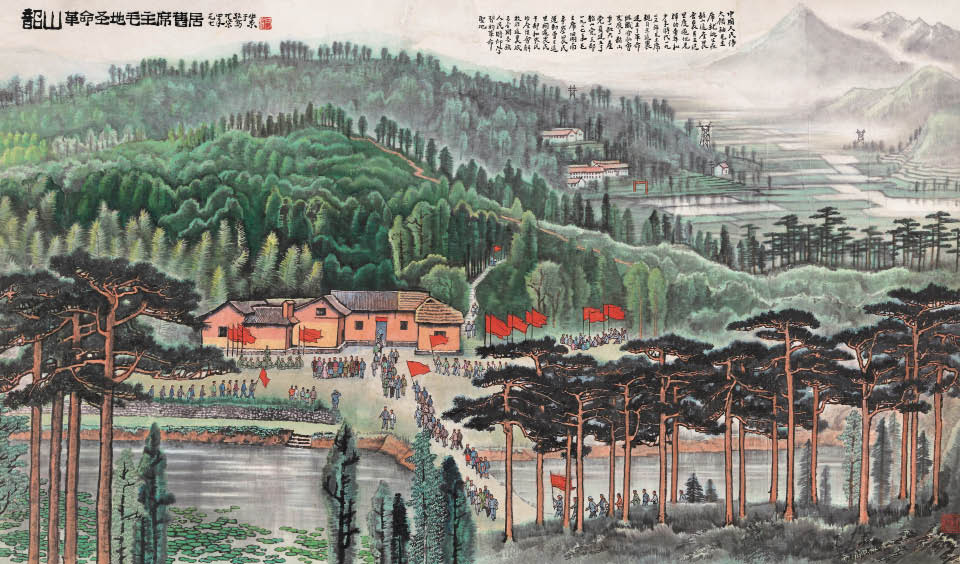| Li Keran’s Shaoshan Captures Art Market

Google “Shaoshan City” and the ensuing blizzard of results will tell you that, above all else, it is the “birthplace of Chairman Mao Zedong, the great Chinese leader.” Shaoshan’s hilly location in Xiangtan, central Hunan Province, has inspired many painted portrayals of this county-level city. Notable among them is Shaoshan-- A Revolutionary Sacred Place and Chairman Mao’s Former Residence by celebrated contemporary painter Li Keran (1907-1989), which fetched RMB 124.2 million on May 12, 2012 at the China Guardian Spring Auction.
Painted in 1974, this was the third and last of Li Keran’s depictions of Shaoshan based on his first, created back in 1969, and second in 1971. At 243.1 cm by 141.5 cm, it is the largest of the three, and has been praised as a masterpiece of organization and expert application of traditional Chinese landscape painting techniques. Looking upwards, the lower section depicts wide, open ponds, straight pines and their interlacing crowns. The upper section delineates the former residence of Chairman Mao, nestled in green clusters of trees that reach to the sky. Horizontally viewing the picture brings into relief terraces on the right dotted with dwellings that give a sense of broad vision. The painting also features human figures -- workers, peasants and soldiers from all over the country bearing red flags on their pilgrimage to Shaoshan. Some walk along the path to Chairman Mao’s former residence, others are leaving, some take group pictures and a few others chat as they sit and rest.
The painting Shaoshan first came up at the China Guardian Auction in 1996, when it sold for RMB 1.54 million — what seemed a fortune at the time, but a miniscule figure compared to the 2012 selling price.
Born in Xuzhou City of Jiangsu Province, Li Keran showed artistic talent from a young age. He started studying Chinese landscape painting in his early teens, and in 1923 enrolled at Shanghai Art College where he studied for two years. In 1929 he entered the Research Section of the State Academy of Arts near the West Lake in Hangzhou. There he studied under celebrated painter Lin Fengmian (1900 -1991), who instantly perceived Li’s talent. In 1947, Li was apprenticed to Qi Baishi (1864-1957), considered one of the ten greatest painters of the 20th century, and studied under him for ten years. He was also apprenticed to Huang Binhong (1865-1955), known as “Master of the Use of Ink.”
During Li Keran’s visit to the German Democratic Republic in 1957 he created several paintings that combined Western contemporary painting techniques, such as focusing on objects’ specific characteristics and use of light and shade, with those of traditional Chinese painting. The modern elements he incorporated into his works contributed to his distinctive style. In 1979, the China Artists Association elected Li as its vice president and the Research Institute of Traditional Chinese Painting made him its president.
Li Keran held several one-man shows at home and abroad. His representative works include Mountain Valleys in Red (Wan Shan Hong Bian); The Incomparable Beautiful Landscape along the Lijiang River (Li Jiang Shan Shui Tian Xia Wu); Gazing at the Mountain (Kan Shan Tu); The Long March (Chang Zheng); and Jinggang Mountains (Jing Gang Shan). Li’s works have fetched astronomical prices at China Guardian auctions. The Long March (Chang Zheng), which Li painted in 1959 to commemorate the 10th anniversary of the founding of New China, fetched RMB 107.52 million at the 2010 autumn auction – an all-time record in the auction history of Chinese contemporary paintings and calligraphic works. Maple Trees in Danxia Landscape (Dan Xia Feng Lin), an imposing, delicately organized piece of work, and considered Li’s representative work during his transitional period, sold for RMB 36.8 million at the 2011 autumn auction. At the 2012 spring auction, his work Mighty Army Crossing the River (Xiong Shi Du Jiang Tu) fetched RMB 12.075 million.
Enthusiasm in the art market for Li’s works never wanes. The estimated price for Mountain Valleys in Red (Wan Shan Hong Bian) that he painted in 1964 hit RMB 293 million at the June 3 Poly International Auction Co., Ltd. spring auction. Although soaring auction prices have triggered dispute in the art industry, they nonetheless signify the depth of market recognition for Li’s works.
|

